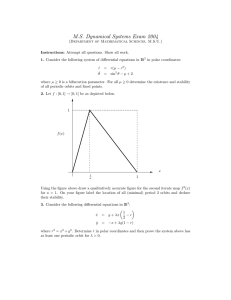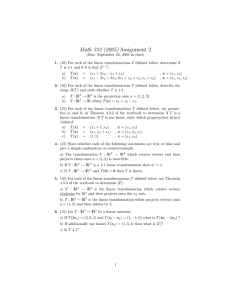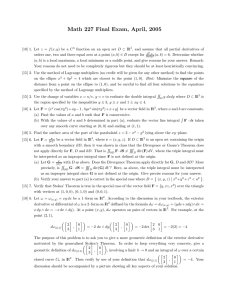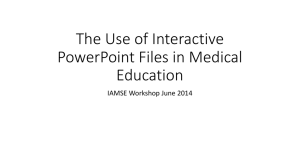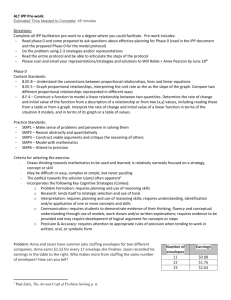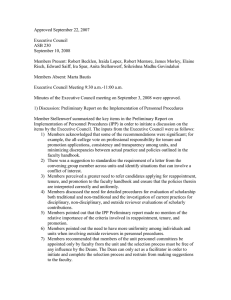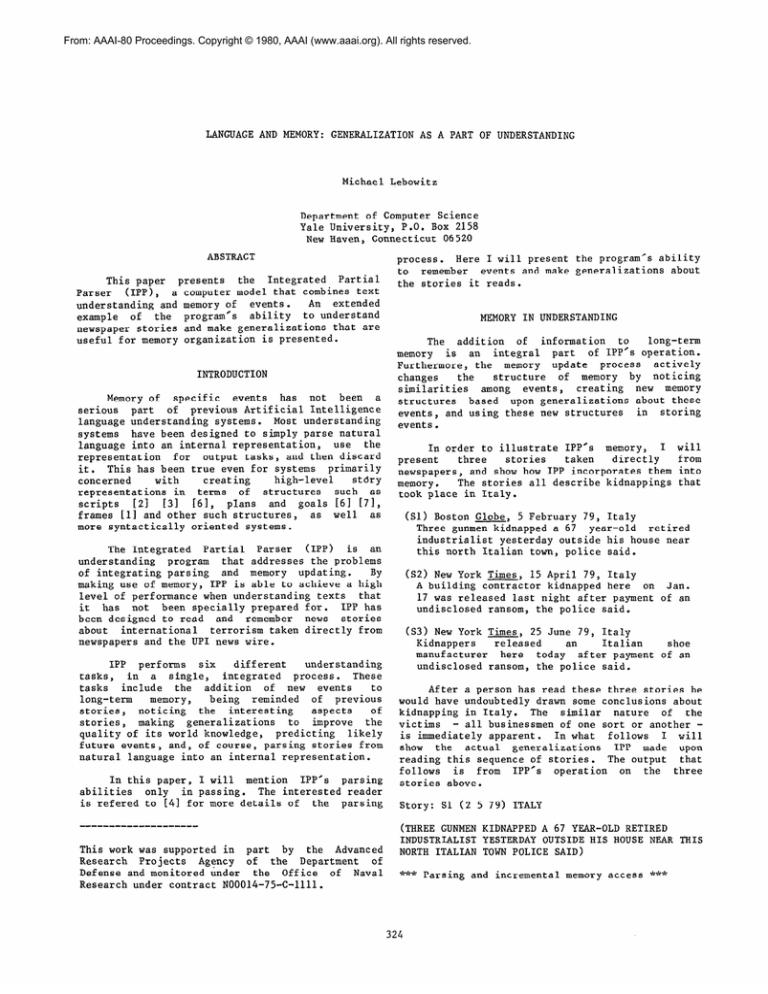
From: AAAI-80 Proceedings. Copyright © 1980, AAAI (www.aaai.org). All rights reserved.
LANGUAGE AND MEMORY: GENERALIZATION AS A PART OF UNDERSTANDING
Michael Lebowitz
Department of Computer Science
Yale University, P.O. Box 2158
New Haven, Connecticut 06520
ABSTRACT
This paper presents the Integrated Partial
Parser (IPP), a computer model that combines text
understanding and memory of events. An extended
example of the program's ability to understand
newspaper stories and make generalizations that are
useful for memory organization is presented.
INTRODUCTION
Memory of specific events has not been a
serious part of previous Artificial Intelligence
language understanding systems. Most understanding
systems have been designed to simply parse natural
language into an internal representation, use the
representation for output tasks, and then discard
it. This has been true even for systems primarily
story
high-level
with
creating
concerned
representations in terms of structures such as
scripts 1121 [31 [6l, plans and goals [6l [71,
frames [II and other such structures, as well as
more syntactically oriented systems.
process. Here I will present the program's ability
to remember events and make generalizations about
the stories it reads.
MEMORY IN UNDERSTANDING
long-term
The addition of information to
memory is an integral part of IPP's operation.
Furthermore, the memory update process actively
structure of memory by noticing
the
changes
similarities among events, creating new memory
structures based upon generalizations about these
events, and using these new structures in storing
events.
In order to illustrate IPP's memory, I will
from
directly
stories
taken
present
three
newspapers, and show how IPP incorporates them into
The stories all describe kidnappings that
memory.
took place in Italy.
(Sl) Boston Globe, 5 February 79, Italy
Three gunmen kidnapped a 67 year-old retired
industrialist yesterday outside his house near
this north Italian town, police said.
The Integrated Partial Parser (IPP) is an
understanding program that addresses the problems
By
of integrating parsing and memory updating.
making use of memory, IPP is able to achieve a high
level of performance when understanding texts that
it has not been specially prepared for. IPP has
been designed to read and remember news stories
about international terrorism taken directly from
newspapers and the UPI news wire.
(S2) New York Times, 15 April 79, Italy
A building contractor kidnapped here on Jan.
17 was released last night after payment of an
undisclosed ransom, the police said.
(S3) New York Times, 25 June 79, Italy
Kidnappers
released
an
Italian
shoe
manufacturer here today after payment of an
undisclosed ransom, the police said.
IPP performs six
different understanding
tasks, in a single, integrated process. These
to
tasks include the addition of new events
long-term memory,
being reminded of previous
of
stories, noticing the interesting aspects
stories, making generalizations to improve the
quality of its world knowledge, predicting likely
future events, and, of course, parsing stories from
natural language into an internal representation.
After a person has read these three stories he
would have undoubtedly drawn some conclusions about
kidnapping in Italy. The similar nature of the
victims - all businessmen of one sort or another is immediately apparent. In what follows I will
show the actual generalizations IPP made upon
reading this sequence of stories. The output that
follows is from IPP's operation on the three
stories above.
In this paper, I will mention IPP's parsing
abilities only in passing. The interested reader
is refered to [41 for more details of the parsing
Story:
--------------------
Sl (2 5 79) ITALY
(THREE GUNMEN KIDNAPPED A 67 YEAR-OLD RETIRED
INDUSTRIALIST YESTERDAY OUTSIDE HIS HOUSE NEAR THIS
NORTH ITALIAN TOWN POLICE SAID)
This work was supported in part by the Advanced
Research Projects Agency of the Department of
Defense and monitored under the Office of Naval
Research under contract N00014-75-C-1111.
*** Parsing and incremental memory access ***
324
>>> Beginning final memory incorporation ...
Story analysis: EVl (S-MOP = S-EXTORT)
HOSTAGES
AGE
OLD
OCCUPATION-TYPE
RETIRED
ROLE
BUSINESSMAN
POL-POS
ESTAB
GENDER
MALE
ACTOR
NUMBER
3
METHODS
SCRIPT
SKIDNAP
NATION
LOCATION
ITALY
Indexing EVl as variant of S-EXTORT
>>> Memory incorporation complete
Stories are represented in IPP by MOPS (Memory
Organization Packets) [51. MOPS were designed to
represent events
in
memory,
and
are
thus
particularly well
suited for the purpose of
maintaining a permanent episodic memory.
Sl is
represented by S-EXTORT, a simple MOP (S-MOP) that
is intended to capture the common aspects of
extortion and SKIDNAP, a script that represents the
low-level events of a kidnapping.
IPP's long term memory is organized around
S-MOPS,
structures that represent generalities
among scripts, and the ways in which different
stories vary from the S-MOPS. The first step in
adding a new story to memory is to extract the
various features of each instantiated S-MOP. These
features consist
of
the
scripts
that
are
instantiated subordinate to the S-MOP (methods and
results, typically), and features from each of the
role fillers (such as the actor and victim). The
output above
shows
the
features
that
IPP
accumulated about the S-EXTORT S-MOP as it read Sl.
Since there were no similar events in memory when
IPP read this story, its addition to memory simply
consisted of indexing it under S-EXTORT using each
of the features as an index.
Creating more specific S-EXTORT (SpMl)
from events EV3 EVl with features:
BUSINESSMAN
ROLE
HOSTAGES
ESTAB
POL-POS
MALE
GENDER
SCRIPT
SKIDNAP
METHODS
ITALY
LOCATION
NATION
Reminded of: EVl (during spec-MOP creation)
[EVl is from Sll
>>> Memory incorporation complete
While reading S2, IPP adds it to long-term
memory. However, as it uses the indexing procedure
described above, it naturally finds Sl, which is
already indexed under S-EXTORT in many of the same
ways as S2 would be. Thus IPP is reminded of Sl,
and what is more, since there are such a large
number of features in common, IPP makes a tentative
generalization that these features normally occur
together. Informally speaking, IPP has concluded
that the targets of kidnappings in Italy are
frequently businessmen.
The new generalization causes the creation of
a new node in memory, known as a spec-MOP, to be
used to remember events that are examples of the
generalization. A spec-MOP is simply a new MOP,
equivalent in kind to the S-MOPS that IPP starts
with, that is used to embody the generalizations
that have been made. The events that went into the
making of the generalization are then indexed off
of the spec-MOP by any additional features they may
have.
Now consider they way IPP reads S2.
The
collection of the features of the S-EXTORT occurs
during parsing of the story.
Story: S2 (4 15 79) ITALY
(A BUILDING CONTRACTOR KIDNAPPED HERE ON JAN 17
WAS RELEASED LAST NIGHT AFTER PAYMENT OF AN
UNDISCLOSED RANSOM THE POLICE SAID)
*** Parsing and incremental memory access ***
Story: S3 (6 25 79) ITALY
>>> Beginning final memory incorporation ...
(KIDNAPPERS RELEASED AN ITALIAN SHOE MANUFACTURER
HERE TODAY AFTER PAYMENT OF AN UNDISCLOSED RANSOM
THE POLICE SAID)
Story analysis: EV3 (S-MOP = S-EXTORT)
RESULTS
SCRIPT
SS-GET-RANSOM
SCRIPT
SS-RELEASE-HOSTAGES
HOSTAGES
ROLE
BUSINESSMAN
POL-POS
ESTAB
GENDER
MALE
METHODS
SCRIPT
SKIDNAP
NATION
LOCATION
ITALY
Processing:
KIDNAPPERS
: Interesting token - KIDNAPPERS
Instantiated SKIDNAP -- S-EXTORT
325
CONCLUSION
>>> Beginning memory update ...
New features: EV5 (S-EXTORT)
SKIDNAP
SCRIPT
METHODS
ITALY
LOCATION
NATION
Best existing S-MOP(s) -- SpMl
[the spec-MOP just created]
Predicted features (from SpMl)
MALE
GENDER
HOSTAGES
ESTAB
POL-POS
BUSINESSMAN
ROLE
>>> Memory update complete
.. [rest of the parsing process]
>>> Beginning final memory incorporation ...
Story analysis: EV5 (S-MOP =
SCRIPT
RESULTS
NATIONALITY
HOSTAGES
ROLE
POL-POS
GENDER
SCRIPT
RESULTS
SCRIPT
METHODS
LOCATION
NATION
S-EXTORT)
SS-GET-RANSOM
ITALY
BUSINESSMAN
ESTAB
MALE
SS-RELEASE-HOSTAGES
SKIDNAP
ITALY
The inclusion of long-term memory as a part of
IPP has been a key factor in allowing the program
to be a powerful, robust understanding system. (To
date it has a vocabulary of about 3200 words and
has processed over 500 stories from newspapers and
producing
an accurate
wire,
UP1
news
the
Furthermore, the
representation for 60 - 70%.)
addition of memory makes possible the inclusion of
many familiar language-related phenomena, such as
reminding and generalization, into a model of the
understanding.
As shown in the examples in this paper, memory
updating can be implemented as a natural part of
language processing. In fact without it, the
ability of a program to fully understand a story is
doubtful, since it cannot improve its knowledge of
the world, and adapt its processing to fit the
knowledge it has obtained - important measures of
the human understanding ability. A program without
episodic memory can never conclude that Italian
kidnappings are often against businessmen, or any
of a myriad of other generalizations that people
make all the time. And that is a crucial part of
understanding.
REFERENCES
Creating more specific S-EXTORT (SpM2) than SpMl
from events EV5 EV3 with features:
SS-GET-RANSOM
SCRIPT
RESULTS
SS-RELEASE-HOSTAGES
SCRIPT
BUSINESSMAN
ROLE
HOSTAGES
ESTAB
POL-POS
MALE
GENDER
SKIDNAP
SCRIPT
METHODS
ITALY
LOCATION
NATION
[II
Reminded of: EV3 (during spec-MOP creation)
[EV3 is from S21
[31 DeJong, G. F. (1979)
Charniak, E. On the use of framed knowledge in
language comprehension. Research Report #137,
Computer
Science,
Yale
Department of
University, 1978.
[21 Cullingford, R. Script application: computer
understanding of newspaper stories. Research
Report #116, Department of Computer Science,
Yale University, 1978
Skimming
time:
An
experiment
Research
understanding.
Computer
Department
of
University.
>>> Memory incorporation complete
As it finishes reading S3, IPP completes its
The
the
new event to memory.
addition
of
processing is basically the same as that we saw for
s2, but instead of beginning the updating process
with the basic S-EXTORT S-MOP, IPP has already
decided that the new story should be considered as
IPP is
a variant of the first spec-MOP created.
able to create another new spec-MOP from S3, this
first
one including all the features of the
spec-MOP, plus the RELEASE-HOSTAGES and GET-RANSOM
results of S-EXTORT. IPP has noticed that these
are frequent results of kidnappings of businessmen
in Italy.
stories in real
in
integrated
#158,
Report
Science, Yale
[41 Lebowitz, M.
Reading with a purpose.
In
Proceedings of 17th Annual Meeting; of the
Association of Computational Linguistics, g
Diego, CA, 1979.
I51 Schank, R. C.
Reminding
and
memory
introduction to
MOPS.
An
organization:
Research Report #l70, Department of Computer
Science, Yale University, 1979.
t61 Schank, R. C and Abelson, R. P.
Plans,
Goals
and Understanding.
Erlbaum Associates, Hillsdale, New
1977.
So after having read these three stories, IPP
has begun to create a model of kidnapping in Italy.
displayed by
behavior
This is the sort of
interested human readers. It is also the kind of
an
cannot
be
captured by
behavior
that
not involve
that
does
understanding
system
long-term memory.
[71 Wilensky, R.
Scripts,
Lawrence
Jersey,
Understanding Goal-Based Stories.
Research Report #l40, Department of Computer
Science, Yale University, 1978.
326


